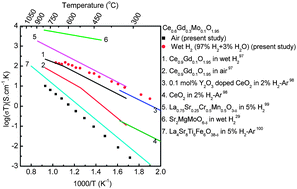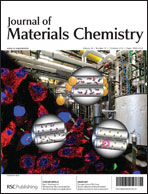In this paper, we report the synthesis, structure, and electrical conductivity of a novel series of Mo and rare earth (RE = Y, Sm, Gd)-doped compounds of the nominal chemical formula of Ce0.9−x RExMo0.1O2.1–0.5x (x = 0.2, 0.3) (CRMO). The formation of cubic fluorite-like structure was confirmed by powder X-ray diffraction (PXRD) and the change in the lattice constant was found to be consistent with the Shannon ionic radius trend. Samples treated under H2 at elevated temperatures were found to retain the original fluorite structure, and the change in the mass is explained using the reduction of both CeIV and MoVI. PXRD also confirmed that the fluorite structure was retained after AC measurements under wet H2 at high temperatures. The electrical conductivity was determined using 2-probe AC and DC methods and was compared with 4-probe DC method in wet H2. The total electrical conductivity obtained from these two different techniques was found to be very close within the experimental error over the investigated temperature. The activation energy for bulk ionic conductivity of CRMO in air was found to be in the range of 0.8–1 eV and comparable to that of RE-doped ceria reported in the literature. Contributions due to ionic and electronic conductivities were studied using electron blocking technique. The total conductivity of CRMO in wet H2 was found to be slightly higher than that of Mo free RE-doped CeO2. Among the samples studied in this work, Ce0.7Sm0.2Mo0.1O2 compound exhibits the highest total conductivity of 7.82 × 10−2 Scm−1 at 450 °C in wet H2 which is comparable to that of perovskite-type La0.75Sr0.25Cr0.5Mn0.5O3−δ. The substitution of Mo in ceria increases the electronic conductivity. The ionic transference number determined using electron blocking electrodes increases with increasing temperature and increasing oxygen partial pressures.. The substitution of Mo in ceria increases the electronic conductivity. The ionic transference number determined using electron blocking electrodes increases with increasing temperature and increasing oxygen partial pressures.

You have access to this article
 Please wait while we load your content...
Something went wrong. Try again?
Please wait while we load your content...
Something went wrong. Try again?


 Please wait while we load your content...
Please wait while we load your content...